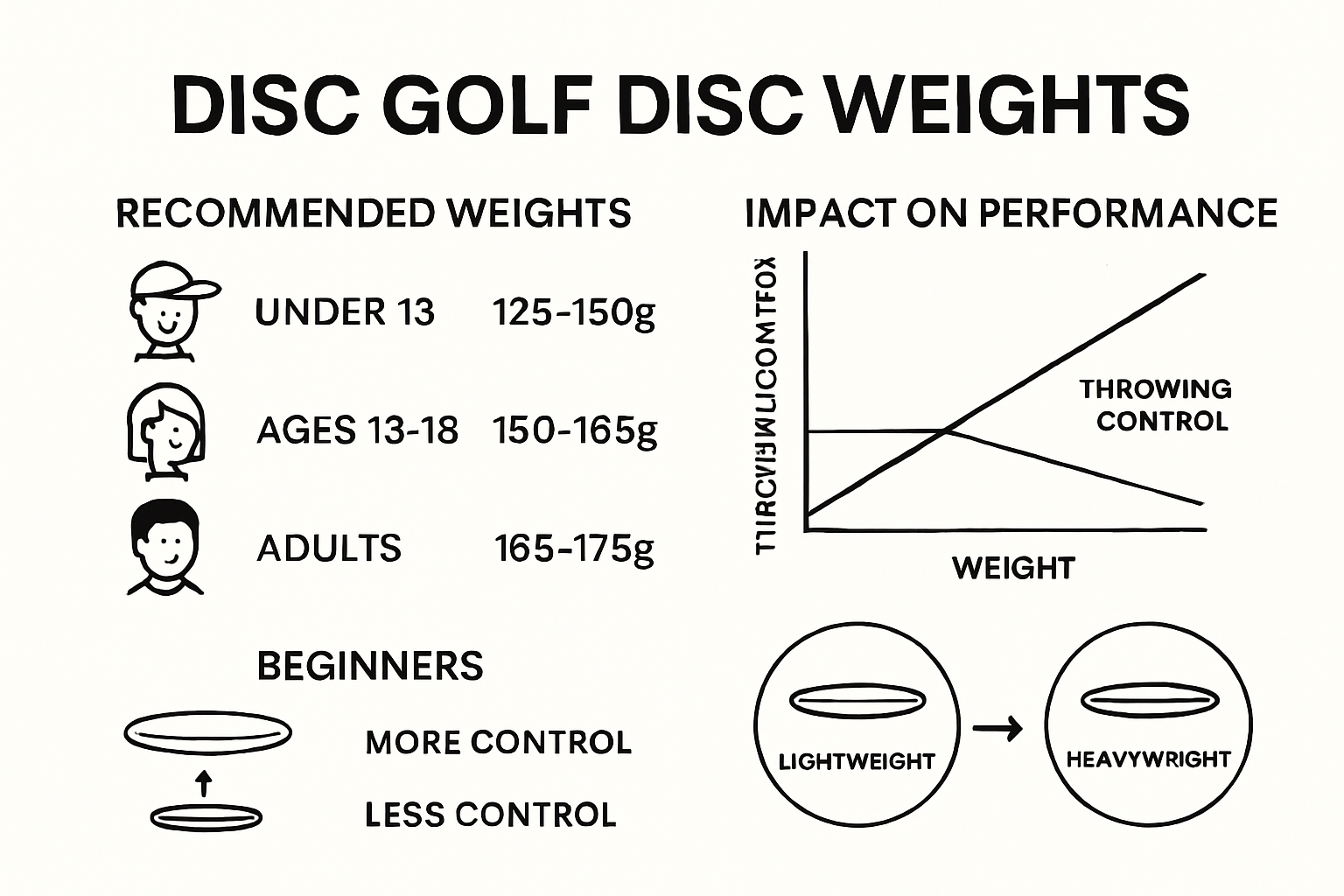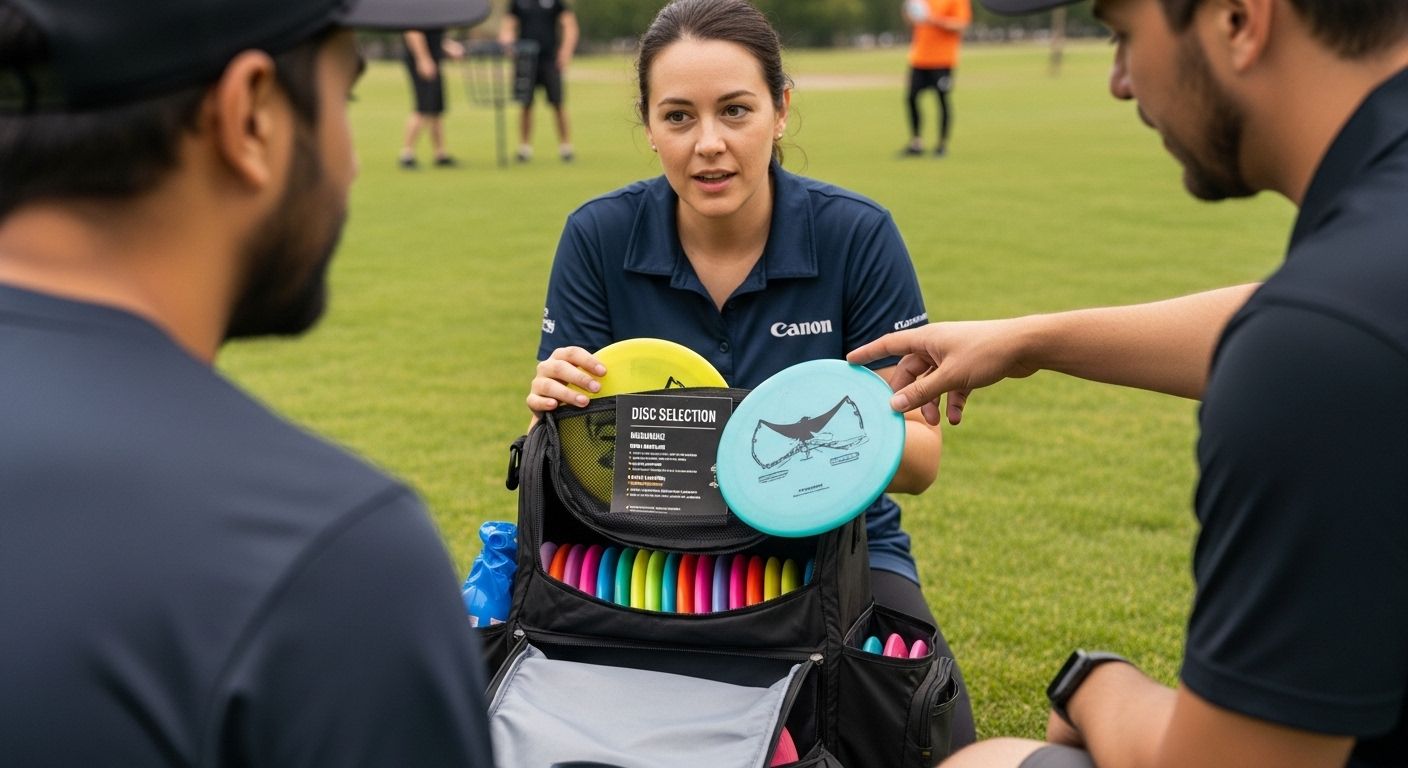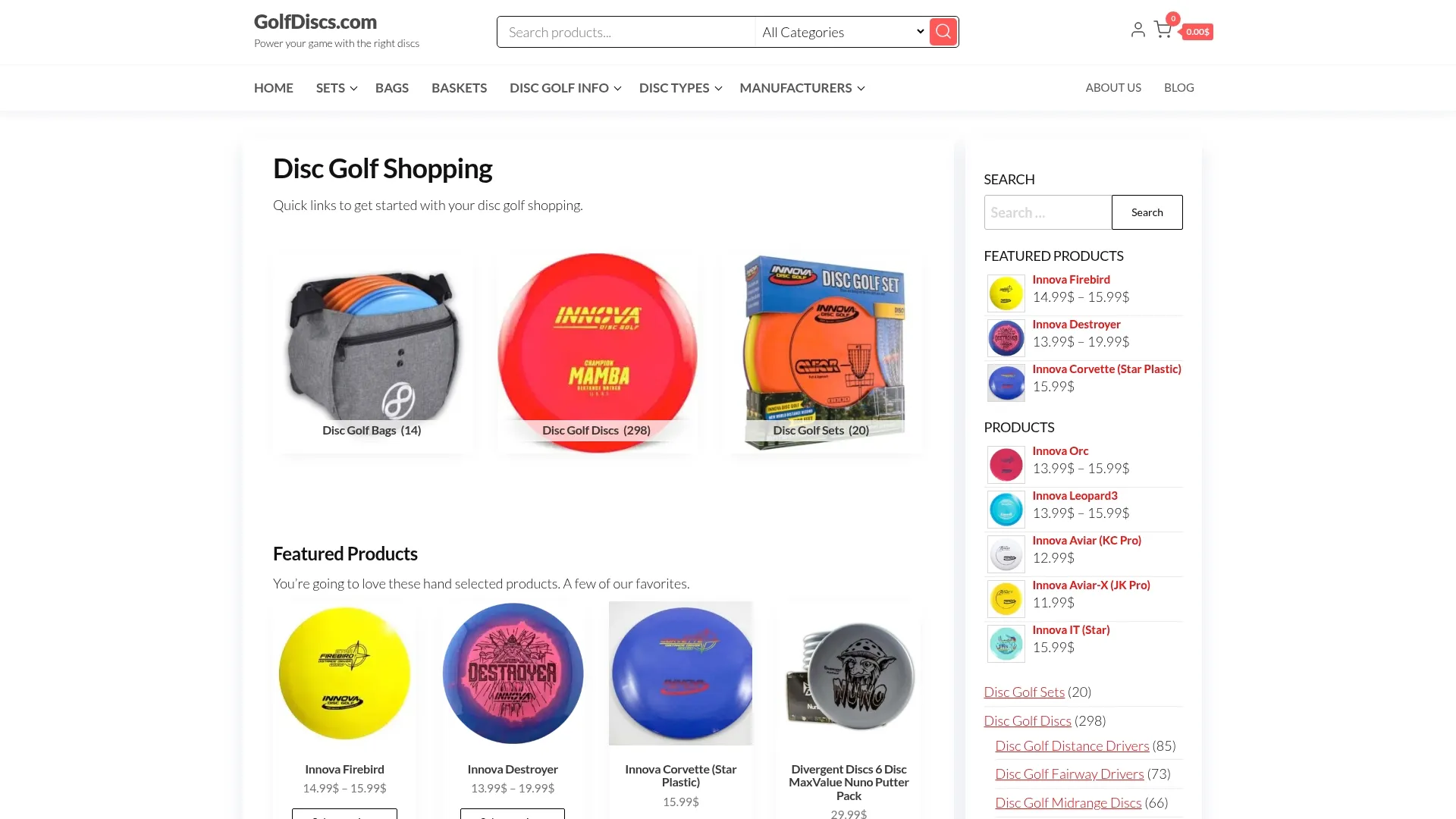
Best Beginner Discs for Easy Throws
Picking your first disc golf disc can feel overwhelming because there are so many choices and each one promises easier throws or better accuracy. Yet most beginners don’t know that discs weighing between 150 and 165 grams are proven the easiest to control for new players. The surprising part? Going lighter and choosing the right kind of disc can actually add more distance to your throw while demanding less power from you. So if you want to make those first rounds fun instead of frustrating, the right disc could make all the difference.
Table of Contents
Quick Summary
| Takeaway | Explanation |
| Choose lightweight discs (150-165g) | Lighter discs are easier to throw and help beginners develop proper form and consistency in their throws. |
| Focus on stable and understable discs | These disc types provide more control, allowing beginners to achieve straighter shots without needing excessive power. |
| Prioritize midrange discs for versatility | Midrange discs are ideal for beginners, as they can be used for driving, approaching, and putting, facilitating skill development. |
| Practice regular disc maintenance | Wipe down discs after play and avoid harsh chemicals to preserve their performance and longevity, ensuring optimal flight characteristics. |
| Consider your throwing style and skill level | Select discs based on your physical capabilities and technique to enhance your learning experience and enjoyment of the game. |
What Makes a Disc Good for Beginners
Choosing the right disc for beginners is more than just picking up any flying object. Understanding the specific characteristics that make a disc beginner-friendly can dramatically improve your early disc golf experience and help you develop proper throwing techniques.
Flight Characteristics for New Players
Understanding disc flight characteristics is crucial for beginners. The Professional Disc Golf Association explains that disc golf discs have four key flight numbers: speed, glide, turn, and fade. For newcomers to the sport, focusing on specific ranges of these numbers can make learning significantly easier.
Speed ratings between 1 and 5 are ideal for beginners. Lower speed discs require less arm strength and provide more predictable trajectories. Glide ratings are equally important – higher glide numbers (between 4 and 6) help discs stay airborne longer, allowing new players to achieve greater distances with less power. Turn ratings between -1 and -3 indicate a disc’s tendency to move right for right-handed backhand throws, which helps create straighter flight paths for developing players.
Disc Types Best Suited for Beginners
Wikipedia’s disc golf overview highlights that mid-range discs and putters are typically recommended for those just starting. These disc types offer more control and forgiveness compared to high-speed drivers. Mid-range discs provide a balanced approach, allowing players to practice various throwing techniques without requiring extreme power or precise technique.
Beginners should prioritize discs with stable to understable flight characteristics. Stable discs fly relatively straight, while understable discs tend to turn more easily, which can help new players achieve better accuracy. Avoiding overstable discs that require significant throwing power is crucial in the early learning stages.
To help new players quickly assess which types of discs are best suited for them, the following table summarizes the ideal disc types for beginners along with key characteristics and common examples mentioned in the article.
| Disc Type | Recommended Weight | Key Characteristics | Example Discs |
| Midrange | 150-165 grams | Easy to control, versatile, balanced flight | Innova Rollo, Discraft Buzzz |
| Putter | 150-165 grams | Precision, control, good grip | Innova Aviar |
| (Starter Set) | 150-165 grams | Includes stable & understable midrange + putter | Varies by set |
When selecting beginner discs, consider lightweight options between 150-165 grams. Lighter discs are easier to throw, require less strength, and help new players develop proper form and technique. They also provide more consistent flight paths, which is essential for building confidence and understanding disc behavior.
Interested in exploring comprehensive disc golf starter sets? These curated collections often include discs specifically chosen to support beginners in developing their skills and understanding of the game. By selecting the right equipment from the start, you can accelerate your learning curve and make the disc golf experience more enjoyable and less frustrating.
Remember, the best disc for a beginner is one that feels comfortable, provides consistent performance, and helps build fundamental throwing skills. Patience, practice, and selecting the right equipment will transform you from a novice to a confident disc golf player.
Top-Rated Beginner Disc Golf Discs
Navigating the world of disc golf can be overwhelming for newcomers, especially when selecting the right discs. Understanding which discs are most suitable for beginners can significantly improve your initial learning experience and help you build confidence on the course.
Recommended Midrange Discs for New Players
Midrange discs are the cornerstone of a beginner’s disc golf arsenal. According to the Professional Disc Golf Association, discs with higher glide ratings travel further with less effort, making them perfect for players developing their technique. The PDGA community discussions highlight several standout midrange discs that consistently receive high marks from experienced players.
Top recommendations include the Innova Rollo, which offers exceptional stability and predictable flight paths. The Discraft Buzzz is another legendary midrange disc known for its incredible accuracy and versatility. These discs provide new players with a reliable throwing experience, helping them understand disc dynamics without becoming frustrated by unpredictable flights.
Putting Discs for Precision and Control
Putting discs are crucial for developing short-range accuracy. Lighter putters between 150-165 grams allow beginners to focus on technique rather than power. The Innova Aviar remains a classic choice, offering excellent grip and consistent performance near the basket. Its straightforward design helps new players build muscle memory and confidence in their putting technique.
For those looking to expand their disc golf skills, exploring comprehensive disc golf sets can provide a curated selection of beginner-friendly discs. These sets typically include a balanced mix of midrange and putting discs that cater specifically to players who are just starting their disc golf journey.
When selecting beginner discs, consider factors beyond just the disc itself. Look for discs with lower speed ratings (1-5), higher glide potential, and understable flight characteristics. These properties make learning more enjoyable and help new players develop proper throwing techniques without becoming discouraged.
Remember that every disc golfer starts somewhere. The key is to choose discs that feel comfortable in your hand, provide consistent performance, and match your current skill level. As you progress, you’ll naturally develop a more nuanced understanding of disc selection and throwing techniques. Patience, practice, and the right equipment will transform you from a novice to a confident disc golf enthusiast.
Tips for Choosing Your First Discs
Selecting your first disc golf discs can feel like navigating a complex landscape of options. The right approach can transform your initial disc golf experience from frustrating to fantastic, setting a solid foundation for your skills and enjoyment of the sport.
Understanding Disc Weight and Characteristics
The Professional Disc Golf Association provides crucial guidance for beginners when selecting discs. Weight plays a critical role in disc performance. For players 13 and older, discs between 150-165 grams offer the best balance of control and distance. Lighter discs (140 grams or less) are recommended for younger players, as they require less arm strength and provide more consistent flight paths.

Mid-range discs are particularly recommended for newcomers. According to the PDGA, these versatile discs can be used for driving, approaching, and putting, making them an economical and practical choice for beginners. Their multi-purpose nature allows new players to develop fundamental skills without investing in multiple specialized discs.
Assessing Your Throwing Style and Skill Level
Your individual throwing technique and physical capabilities should guide disc selection. Beginners should prioritize discs with lower speed ratings (1-5) and higher glide potential. These characteristics compensate for developing throwing skills by providing more forgiving flight paths and increased distance with less power.
Consider your physical strength and flexibility when choosing discs. Understable discs with negative turn ratings help new players achieve straighter flights and build confidence. Avoid overstable discs that require significant throwing power, as these can lead to frustration and potentially discourage continued practice.
Practical Recommendations for First-Time Buyers
Before making a purchase, handle different discs to understand their grip and feel. Many disc golf shops offer practice areas where you can test discs. Explore comprehensive disc golf sets that provide a curated selection of beginner-friendly discs, which can simplify the selection process for newcomers.
Start with a small, focused collection. A typical beginner set might include:
-
One stable midrange disc
-
One understable midrange disc
-
A putter for short-range accuracy
Remember that disc golf is a skill-based sport. Your first set of discs is a learning tool, not a permanent collection. As you develop your technique, you’ll naturally understand which types of discs complement your throwing style.

Practice and patience are your greatest allies. Don’t get discouraged by initial challenges. Each throw is an opportunity to learn and improve. Seek advice from local disc golf communities, watch tutorial videos, and most importantly, enjoy the process of learning this engaging outdoor sport.
How to Care for Your Discs Outdoors
Proper disc maintenance is crucial for preserving the performance and longevity of your disc golf equipment. Outdoor environments present unique challenges that can quickly degrade your discs if you’re not proactive about their care and protection.
Environmental Challenges and Disc Protection
Disc golf is an outdoor sport that exposes your equipment to various environmental elements. Sunlight, moisture, extreme temperatures, and rough terrain can all impact your disc’s performance and durability. The Professional Disc Golf Association provides specific guidelines about disc modifications and wear, emphasizing that natural wear from play is acceptable, but significant alterations can render a disc illegal for tournament play.
UV rays can cause significant damage to disc plastics, potentially changing their flight characteristics and structural integrity. Store your discs in a cool, dark place when not in use, and avoid leaving them in direct sunlight for extended periods. Temperature fluctuations can cause warping, so never leave discs in a hot car or exposed to freezing conditions for long periods.
Cleaning and Maintenance Techniques
Regular cleaning is essential for maintaining disc performance. After each round, wipe down your discs with a soft, damp cloth to remove dirt, mud, and debris. Avoid using harsh chemicals or abrasive materials that could damage the disc’s surface. For stubborn dirt, use mild soap and water, then thoroughly dry the disc to prevent water damage.
Inspect your discs regularly for signs of wear, such as deep scratches, cracks, or significant nicks. Minor surface imperfections are normal, but deep damage can affect the disc’s flight characteristics. Some light sanding can help smooth out minor imperfections, but be cautious not to alter the disc’s original shape or weight.
Storage and Transportation Tips
Proper storage is key to preserving your disc golf collection. Invest in a quality disc golf bag with individual compartments that protect discs from bumping into each other. Avoid storing discs loosely, as this can cause unnecessary wear and potential damage. When transporting discs, use padded bags or protective cases that shield them from impact and extreme temperatures.
Consider the type of plastic when determining care strategies. Different plastic types have varying levels of durability and sensitivity to environmental conditions. Some premium plastics resist wear better, while others may require more careful handling. Understanding how plastic types impact disc performance can help you develop a more targeted maintenance approach.
For disc golfers who play in challenging conditions, such as winter or extremely humid environments, additional precautions are necessary. Always clean and dry your discs thoroughly after playing in wet or muddy conditions. In winter, be extra cautious about temperature changes that can cause plastic brittleness.
Proper care and maintenance are essential for extending the lifespan and performance of your discs. The following table organizes key care tips and measures for disc protection based on the article.
| Care Aspect | Recommended Practice | Benefit |
| Sun/Heat Protection | Store discs in cool, dark places; avoid hot cars | Prevents warping & UV damage |
| Cleaning | Wipe with damp cloth; use mild soap for stubborn dirt | Maintains grip and consistent flight |
| Avoid Chemicals | Do not use harsh chemicals or abrasives | Prevents surface and structural damage |
| Damage Inspection | Check regularly for cracks, deep scratches, nicks | Ensures optimal flight characteristics |
| Storage | Use padded bag with dividers, don’t store loosely | Reduces wear and prevents deformation |
| Plastic Type Consideration | Adjust care based on disc plastic type | Maximizes durability and longevity |
Remember that proper disc care is an investment in your disc golf performance. By taking a few simple steps to protect and maintain your discs, you can extend their lifespan, maintain their flight characteristics, and ensure consistent performance on the course. Treat your discs like the precision sporting equipment they are, and they’ll reward you with reliable throws and long-lasting use.
Frequently Asked Questions
What are the best types of discs for beginner disc golfers?
Beginner disc golfers should focus on midrange discs and putters that weigh between 150-165 grams. These discs are easier to control, provide more stability, and help with developing proper throwing techniques.
How does disc weight affect throwing performance for beginners?
Lighter discs (150-165 grams) are easier for beginners to throw and manage, allowing for better control and accuracy. They also help new players achieve longer distances without requiring excessive strength or technique.
What flight characteristics should beginners look for in disc golf discs?
Beginners should prioritize discs with lower speed ratings (1-5), higher glide ratings (4-6), and understable characteristics. These features make the discs more forgiving and help achieve straighter flight paths, improving learning experiences.
How can beginners ensure their discs last longer?
To extend the lifespan of disc golf discs, store them in a cool, dark place to prevent UV damage and warping. Clean them regularly with a soft damp cloth, avoid using harsh chemicals, and inspect for damage after play to maintain performance.
Take the First Step Toward Effortless Disc Golf Throws
Tired of confusion when choosing your first disc golf discs? Many new players struggle with overwhelming disc choices, the challenge of finding lightweight and beginner-friendly discs, and not knowing what really helps to build accuracy and confidence. You learned in the article that discs weighing 150 to 165 grams with stable or understable flight characteristics can completely transform your first rounds on the course. But having the right knowledge is only the beginning—finding trusted discs designed for beginners is where true progress starts.

Now is the perfect moment to put your learning into action. Visit golfdiscs.com and discover a wide range of discs made specifically for new players. By exploring their disc golf sets or reviewing curated options on their disc selection page, you can take the guesswork out of your purchase and start playing with confidence. Be one of the beginners who skips the frustration and jumps straight to easy, enjoyable throws—get started today.
